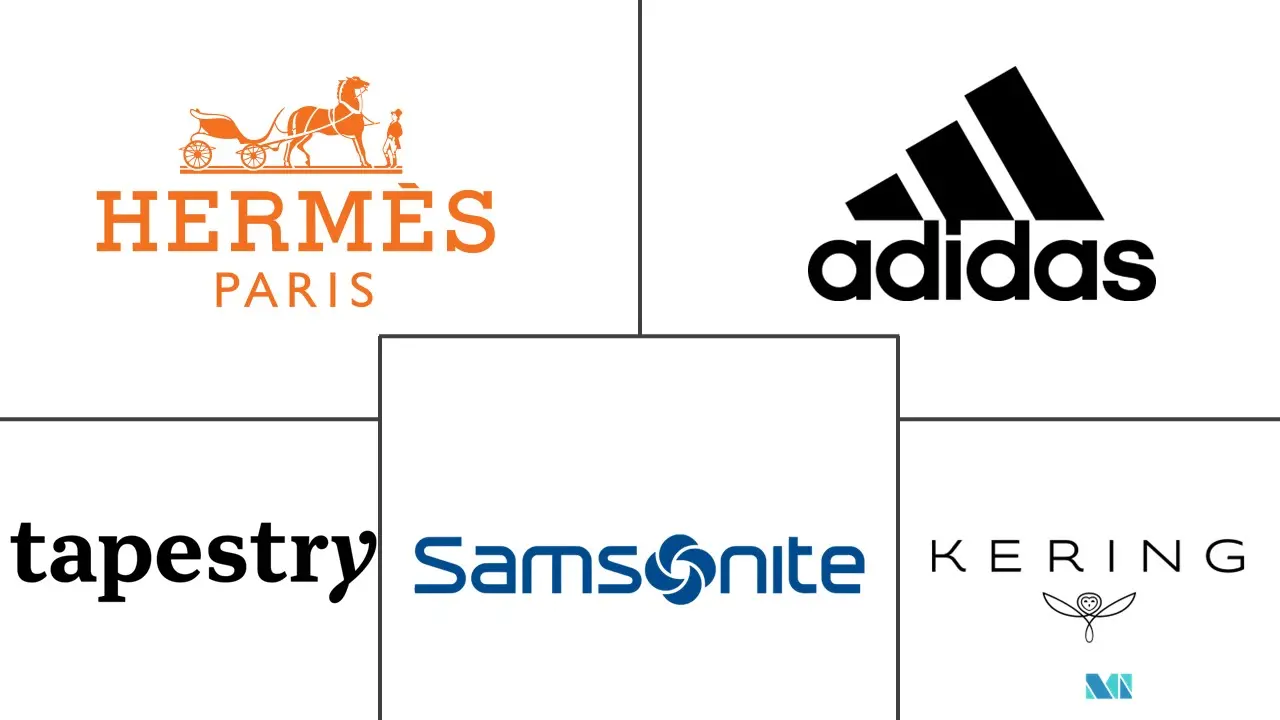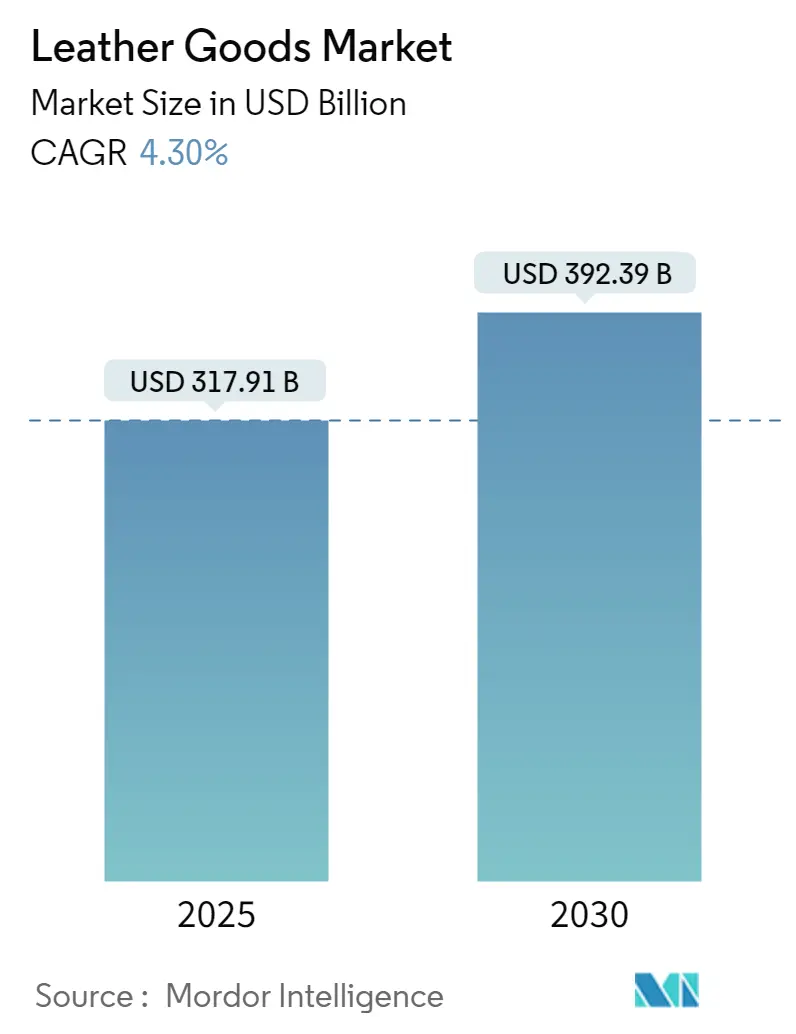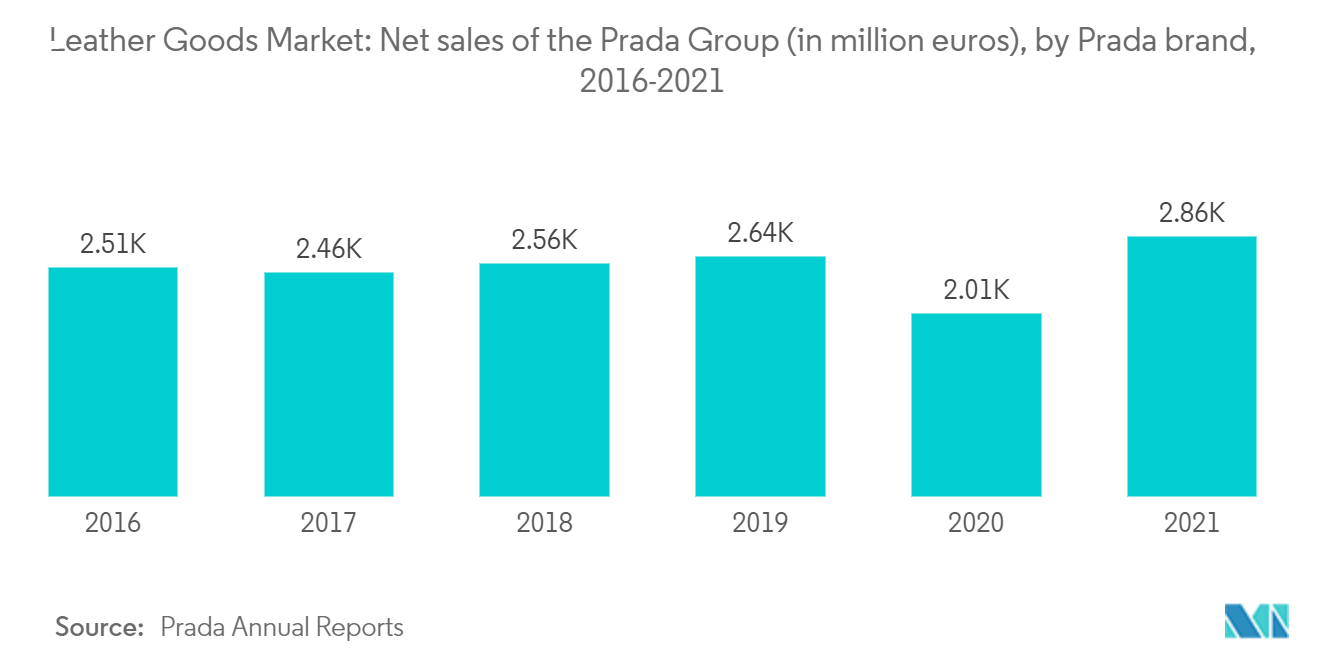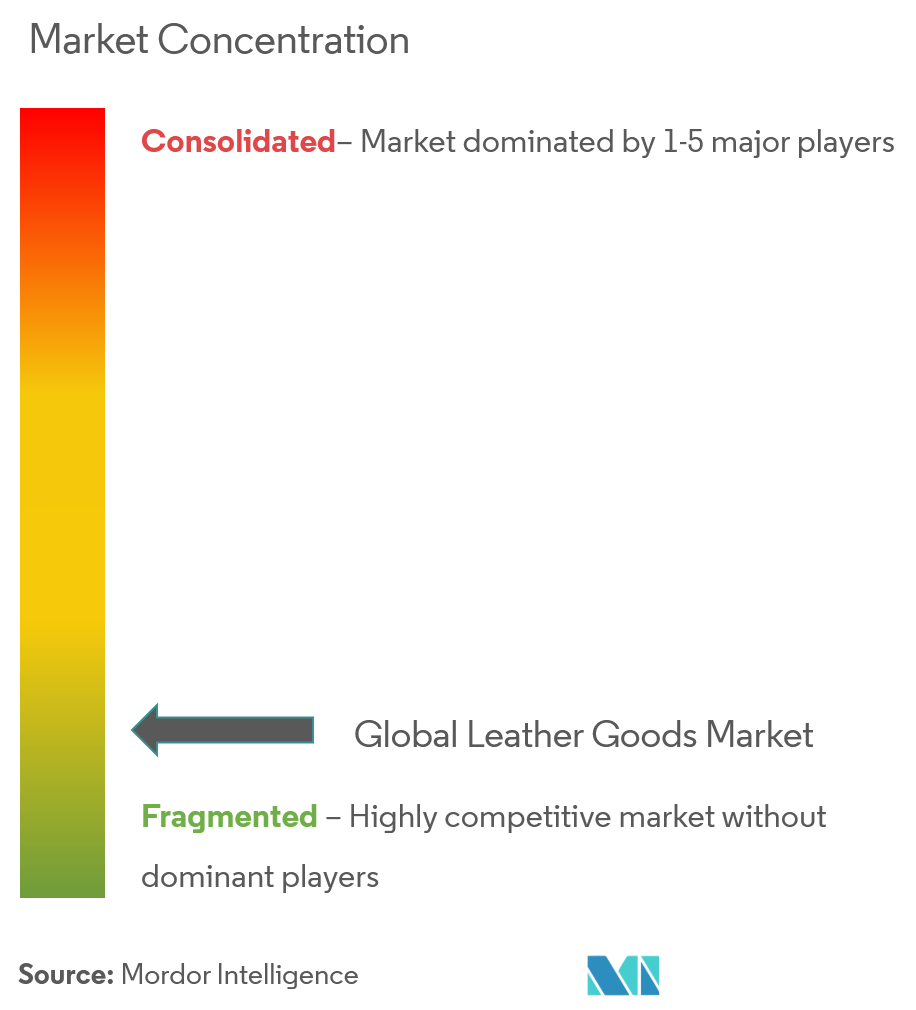Leather Goods Market Analysis
The Leather Goods Market size is estimated at USD 317.91 billion in 2025, and is expected to reach USD 392.39 billion by 2030, at a CAGR of 4.3% during the forecast period (2025-2030).
In the clothing industry, there is an increased use of leather due to its durable nature and premium appearance, which make it an excellent choice for clothing production. This is one of the major factors driving the uptake of leather in the market at the moment. Furthermore, leather goods are becoming increasingly popular as a result of fashion shows that showcase leather goods like jackets, shoes, bags, and other accessories that are promoting leather goods in the forecast period. The market players are introducing innovative and trendy products to meet the demands of the consumers and to maintain a loyal customer base, which is contributing to the growth of the market.
Additionally, consumers prefer compact and stylish leather goods and luggage. With changing fashion trends, men's accessories like leather bracelets, necklaces, and gloves are becoming increasingly popular. Thus, in the coming years, fashion trends are likely to change significantly, which will help to grow the industry. Furthermore, the growing government support for the leather industry is further driving market growth. For instance, in India, 100% FDI is allowed for the manufacturing of leather products through an automatic route. Between April 2000 and September 2021, the cumulative foreign direct investment (FDI) inflow in the case of the leather, leather goods, and pickers industries was USD 218.69 million.
Leather Goods Market Trends
Increased Demand for Luxury Goods
As people's spending money has gone up, the demand for luxury goods has also gone up.These goods often symbolize a sense of accomplishment within individuals, giving them higher self-esteem. Europeans and North Americans are known to spend most on luxury goods, owing to their higher household incomes. An upward thrust can be seen in this matter in the Asian region as well. Leather goods form a major part of luxury goods. Luxury leather products include exclusive handbags, accessories, and shoes, which appeal to affluent individuals.
Hence, the companies are expanding their product portfolios with new product launches to attract extravagant customers. For instance, in August 2022, luxury brand Aman Essentials launched the first collection of leather products in its extensive range. In addition to passport cases, handbags, wallets, and more, the brand's new Leather Collection includes 19 items. Using authentic leathers sourced from artisanal calf, lamb, and goat skins, each of the leather items in the new collection is handcrafted in Italy and France using a process that is inspired by traditional artisanal processes.
Furthermore, various brands are expanding their product portfolios in the men's segment as fashion consciousness grows among men and women. There is also a growing segment of the market for affordable luxury brands in addition to traditional luxury brands. As a result, a number of startups have created customized luxurious products that cater to the needs of consumers. A leather handbag from 1 Atelier, for example, can be customized in both color and hardware. Sales of these products are driven by their strong brand recognition and high unit price.
Europe Emerges as the Largest Consumer of Leather Goods
Some of the main things that are making the European market grow are the large number of local and international players, new products and technologies, the rise of online shopping, and the use of social media platforms.The increasing fashion consciousness, rising disposable incomes, and increasing demand for attractive bags drive the sales of luggage and leather goods in the region. Moreover, the growing interest in travel and unique experiences among consumers is boosting the demand for leather goods, such as luggage bags, especially in the luxury segment, as consumers increasingly look for high-quality items. Furthermore, with the strong presence of fashion-driven countries such as France and Italy, the region remains the market's largest consumer.
In the international leather trade, Europe plays an important role. According to the UN Comrade database, in 2021, the number of leather goods imported into France increased significantly, reaching approximately USD 5.22 billion, up from USD 4.2 billion in the previous year. Additionally, leather is the world's largest international export from the EU industry. Among the leather goods exported by Europe in 2021, approximately USD 31.9 billion, compared to USD 24.8 billion the previous year, was reported by the International Trade Centre. In terms of raw materials and leather, the European Union produces some of the highest-valued calfskins. A majority of tanners in the European Union are family-owned, small- and medium-sized enterprises with strong regional concentrations. The availability of raw materials and export markets is crucial for tanners in the European Union.
Leather Goods Industry Overview
The leather goods market is highly competitive. In the organized sector, a few key players hold a major market share, whereas in the unorganized sector, many small players are competing to gain market share. Adidas, Samsonite, and Kering are some prominent players in the global market. Major players are focusing on introducing new product offerings in the market to cater to the interests of consumers as per the ongoing fashion trend among goods like footwear, accessories, and luggage bags. Expansion is the next strategy preferred by companies to strengthen their dominance in the leather goods market. Major players are constantly trying to expand their production facilities or retail outlets to accommodate the growing demand and strengthen their strategies for market development.
Leather Goods Market Leaders
-
Kering SA
-
Samsonite IP Holdings S.ÀR.L.
-
Tapestry, Inc.
-
Adidas AG
-
Hermès International S.A.
- *Disclaimer: Major Players sorted in no particular order
Leather Goods Market News
- October 2022: LVMH expanded its presence in Italy with the opening of new Fendi and Bulgari production facilities. Even though costs are going up, LVMH keeps putting a lot of money into its Italian production line.
- October 2022: Prada, a high-end fashion brand, recently opened a factory near Sibiu, Romania. In the new factory, Prada will manufacture parts of its leather products. Hipic Prod Impex, now part of the Prada group, operates the factory in Sibiu's West Industrial Zone, measuring 31,000 square feet.
- April 2022: In conjunction with a USD 3 million philanthropic grant from the Tapestry Foundation, which promotes social and environmental justice, Tapestry, Inc., a New York-based luxury accessories and lifestyle brand house including Coach, Kate Spade, and Stuart Weitzman, announced a partnership with the World Wildlife Fund (WWF). In order to encourage a more sustainable future for the leather industry in Brazil, this grant will be used to develop an innovative system for enhancing traceability within the leather value chain.
Leather Goods Industry Segmentation
Leather goods are products made out of material from tanning hides and the skin of animals, mainly cattle. The process of tanning helps prevent the leather from being damaged while also smoothing its texture. The leather goods market is segmented on the basis of product type, distribution channel, and geography. Based on product type, the market is segmented into footwear, luggage, and accessories. The market is segmented by distribution channel into offline and online retail stores. The research also includes a global level analysis of the major regions, which include North America, Europe, Asia-Pacific, South America, the Middle East, and Africa. The market sizing and forecasts for each segment are based on value (in USD million).
| By Product Type | Footwear | ||
| Luggage | |||
| Accessories | |||
| By Distribution Channel | Offline Retail Stores | ||
| Online Retail Stores | |||
| Geography | North America | United States | |
| Canada | |||
| Mexico | |||
| Rest of North America | |||
| Europe | Spain | ||
| United Kingdom | |||
| Germany | |||
| France | |||
| Italy | |||
| Russia | |||
| Rest of Europe | |||
| Asia-Pacific | China | ||
| Japan | |||
| India | |||
| Australia | |||
| Rest of Asia-Pacific | |||
| South America | Brazil | ||
| Argentina | |||
| Rest of South America | |||
| Middle-East and Africa | South Africa | ||
| United Arab Emirates | |||
| Rest of Middle-East and Africa | |||
Leather Goods Market Research FAQs
How big is the Leather Goods Market?
The Leather Goods Market size is expected to reach USD 317.91 billion in 2025 and grow at a CAGR of 4.30% to reach USD 392.39 billion by 2030.
What is the current Leather Goods Market size?
In 2025, the Leather Goods Market size is expected to reach USD 317.91 billion.
Who are the key players in Leather Goods Market?
Kering SA, Samsonite IP Holdings S.ÀR.L., Tapestry, Inc., Adidas AG and Hermès International S.A. are the major companies operating in the Leather Goods Market.
Which is the fastest growing region in Leather Goods Market?
Asia-Pacific is estimated to grow at the highest CAGR over the forecast period (2025-2030).
Which region has the biggest share in Leather Goods Market?
In 2025, the Europe accounts for the largest market share in Leather Goods Market.
What years does this Leather Goods Market cover, and what was the market size in 2024?
In 2024, the Leather Goods Market size was estimated at USD 304.24 billion. The report covers the Leather Goods Market historical market size for years: 2019, 2020, 2021, 2022, 2023 and 2024. The report also forecasts the Leather Goods Market size for years: 2025, 2026, 2027, 2028, 2029 and 2030.
Our Best Selling Reports
Leather Goods Industry Report
The global leather goods market is driven by rising disposable income, changing fashion trends, and a demand for trendy leather products. With a focus on both genuine and synthetic leather, the market sees a surge in eco-friendly and cost-effective synthetic leather options. Footwear and automotive accessories lead the growth segments, while innovations in synthetic and vegan leather cater to eco-conscious consumers. Europe emerges as a key market due to its fashion influence and leather trade significance. The market's expansion is fueled by luxury goods demand and product innovation, reflecting shifts in consumer preferences. Statistics for the Leather Goods market share, size, and revenue growth rate, created by Mordor Intelligence™ Industry Reports. Leather Goods analysis includes a market forecast outlook and historical overview. Get a sample of this industry analysis as a free report PDF download.







